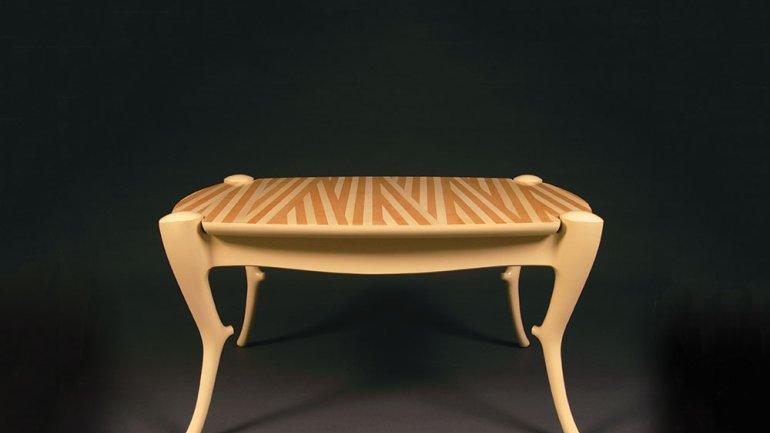Animated by Design
Animated by Design
It’s hard enough to pull off humor in art, much less combine humor and elegance in the same piece. The whole thing can end up a painfully awkward match, like a bad blind date.
When it works, though, the union can be sublime. And Jack Mauch seems to have the touch. Not only can he switch effortlessly from one extreme (his exquisite salt and pepper shakers) to the other (the chicken-legged tavern mug), he can blend the two into one seamless whole.
Case in point: His 2011 end table, with a bold red trefoil as the top, pure midcentury design. But as your eye moves down the piece, the three lobes morph into haunches, ending in a trio of ungulate legs, supporting the piece on the edge of its implicit hooves. A 2011 coffee table accomplishes a similar feat; it’s a clean, beautifully worked surface held up by ... branches? Some kind of delicate miniature deer legs? Or is the table, almost lighter than air, balancing on its tippy-toes?
He embraces all of these interpretations. “I hate the word ‘whimsy,’ but I want the work to have character,” he says – and it also has to make sense visually. “It’s really important to me that the imagery and narrative is inspiration but doesn’t usurp solid formal design,” he says. “I’m still making logical design decisions.”
Mauch’s eclectic, refined sensibility is accompanied by an impressive facility across several mediums. He moves with apparently equal ease among ceramics, wood, and metal, and each new medium, he says, has proven a new avenue to advance his vision.
The vision began at an early age. The youngest of five, Mauch grew up in an artistic family in New Hampshire; he drew comics, did printmaking, and just for fun, made stop-motion films with a pal. He didn’t even think about craft until his freshman year at the Maine College of Art, when he signed up for ceramics. “It was the most engaging thing I’d ever done. I just fell in love with the craft culture. I loved the emphasis on function. And throwing on the wheel is one of the most magical things you can do.”
After graduating in 2006, he moved to Cambridge, Massachusetts. With his experience building theater sets in high school and working with wood in college, he got a “fabulous job” building exhibitions for the Harvard Graduate School of Design. Looking back, he says, it was as influential an experience as his formal schooling.
“A lot of my experience was translating people’s very visionary designs, so I was taking someone’s idea and making it so it would respect the laws of physics. I got to learn so much about design, construction, how to make things work but also appear really original and different.”
He continued to feel the tug of his own work, though, and applied for a two-year core fellowship at Penland School of Crafts, to begin in 2011. He intended to return to ceramics, but once there, he realized he was thinking more like a designer. To that end, he began working with metal and made a number of tools, including a series of pocket knives, which presented him with another technical and design challenge. Within the form’s very specific functional constraints, he sought to express his ongoing fascination with dynamic shifts in volume and graceful contour lines, all elements writ larger in his later furniture pieces.
The knives might seem merely a curious detour, but the series – and indeed all his work, he says – has been an integral part of his evolution.
With his fellowship over, he will be moving back to New Hampshire this summer, to concentrate on his furniture making, which he sees as the best vehicle to continue to develop his design sense.
Ultimately he hopes to sell his work – to make a living, of course, and to share some kind of meaning with the people who will own it. But somehow it’s just as important for the objects themselves to get out in the world, Mauch says. Who’s to say it’s his vision that imbues them with meaning? Maybe he’s simply releasing intrinsic spirits. Either way, he wants to know they found a good home.
Judy Arginteanu is American Craft’s copy editor.

